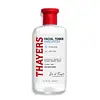What's inside
What's inside
 Benefits
Benefits

 Concerns
Concerns

 Ingredients Side-by-side
Ingredients Side-by-side

Water
Skin ConditioningGlycerin
HumectantButylene Glycol
HumectantAlcohol Denat.
AntimicrobialPEG-40 Hydrogenated Castor Oil
EmulsifyingPhenoxyethanol
PreservativeFomes Officinalis Extract
Skin ProtectingDisodium EDTA
PEG-10 Sunflower Glycerides
EmollientMenthol
MaskingCamellia Oleifera Seed Extract
AstringentSalix Nigra Bark Extract
Skin ProtectingHamamelis Virginiana Extract
AntiseborrhoeicPropylene Glycol
HumectantCalendula Officinalis Flower Extract
MaskingAnthemis Nobilis Flower Extract
MaskingTilia Cordata Flower Extract
Skin ConditioningCentaurea Cyanus Flower Extract
AstringentChamomilla Recutita Extract
Skin ConditioningHypericum Perforatum Extract
AntimicrobialCI 42090
Cosmetic ColorantWater, Glycerin, Butylene Glycol, Alcohol Denat., PEG-40 Hydrogenated Castor Oil, Phenoxyethanol, Fomes Officinalis Extract, Disodium EDTA, PEG-10 Sunflower Glycerides, Menthol, Camellia Oleifera Seed Extract, Salix Nigra Bark Extract, Hamamelis Virginiana Extract, Propylene Glycol, Calendula Officinalis Flower Extract, Anthemis Nobilis Flower Extract, Tilia Cordata Flower Extract, Centaurea Cyanus Flower Extract, Chamomilla Recutita Extract, Hypericum Perforatum Extract, CI 42090
 Reviews
Reviews

Ingredients Explained
These ingredients are found in both products.
Ingredients higher up in an ingredient list are typically present in a larger amount.
Glycerin is already naturally found in your skin. It helps moisturize and protect your skin.
A study from 2016 found glycerin to be more effective as a humectant than AHAs and hyaluronic acid.
As a humectant, it helps the skin stay hydrated by pulling moisture to your skin. The low molecular weight of glycerin allows it to pull moisture into the deeper layers of your skin.
Hydrated skin improves your skin barrier; Your skin barrier helps protect against irritants and bacteria.
Glycerin has also been found to have antimicrobial and antiviral properties. Due to these properties, glycerin is often used in wound and burn treatments.
In cosmetics, glycerin is usually derived from plants such as soybean or palm. However, it can also be sourced from animals, such as tallow or animal fat.
This ingredient is organic, colorless, odorless, and non-toxic.
Glycerin is the name for this ingredient in American English. British English uses Glycerol/Glycerine.
Learn more about GlycerinPhenoxyethanol is a preservative that has germicide, antimicrobial, and aromatic properties. Studies show that phenoxyethanol can prevent microbial growth. By itself, it has a scent that is similar to that of a rose.
It's often used in formulations along with Caprylyl Glycol to preserve the shelf life of products.
Water. It's the most common cosmetic ingredient of all. You'll usually see it at the top of ingredient lists, meaning that it makes up the largest part of the product.
So why is it so popular? Water most often acts as a solvent - this means that it helps dissolve other ingredients into the formulation.
You'll also recognize water as that liquid we all need to stay alive. If you see this, drink a glass of water. Stay hydrated!
Learn more about Water